NVIDIA GeForce GTS 450 Launch Roundup: Asus, EVGA, Palit, and Calibre Overclocked and Reviewed
by Ryan Smith on September 13, 2010 6:08 PM ESTOverclocked Performance
The GTS 450 is already supported by the latest version of MSI’s excellent afterburner software, and keeping with their policy MSI has enabled overvoltage support for all cards using the same VRMs as the reference card. So we were able to overvolt all of our vendor cards, even those that do not officially support voltage control. The VRMs on all of the cards except the Asus card top out at 1.162v, however for safety reasons (and the fact that except on the Asus card the VRMs aren’t even passively cooled) we limited ourselves to 1.15v.
As not all of our cards are exactly alike, we’ll quickly run down the differences between the various cards
| Overclocking Results | ||||||
| Stock Clock | Max Overclock | Stock Voltage | Overclocked Voltage | |||
| GTS 450 Reference #1 | 783MHz | 955MHz | 1.05v | 1.115v | ||
| GTS 450 Reference #2 | 783MHz | 930MHz | 1.062v | 1.115v | ||
| Asus ENGTS450 Top | 925MHz | 985MHz | 1.125v | 1.115v | ||
| EVGA GTS 450 FTW | 920MHz | 955MHz | 1.112v | 1.115v | ||
| Palit GTS 450 Sonic Platinum | 930MHz | 985MHz | 1.087v | 1.115v | ||
| Sparkle Calibre X450G | 850MHz | 935MHz | 1.087v | 1.115v | ||
Out of the 4 cards in today’s roundup, we got fairly wide range of overclocking, with the top and bottom cards varying by 50MHz. The VID of the GPU had little impact on the final overclock, as we had a 1.087v card turn in the lowest overclock while a 1.125v card turned in the highest overclock. Excluding the Calibre card, the cards with the best cooling did get the best overclocks, but temperature doesn’t look to be a serious factor here as we’ve already seen that temperatures barely crack 70C. So the overclockability of any card (including these factory overclock cards) looks to be the luck of the draw, with the factory overclocked cards removing the chance of getting a dud GPU that won’t break 900MHz.
The Asus and the Palit cards maxed out at both the same core clock and the same memory clock – 985MHz and 1050MHz (4.2GHz effective) respectively, returning the same performance as a result. Elsewhere the EVGA card got the next best overclock, followed by the Calibre.

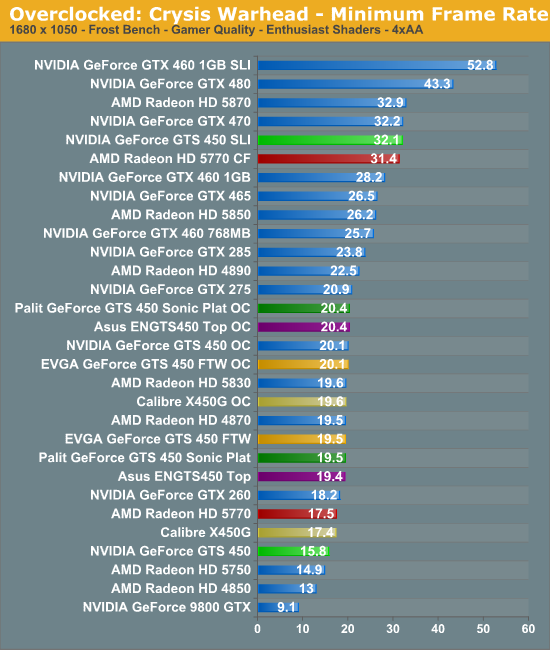
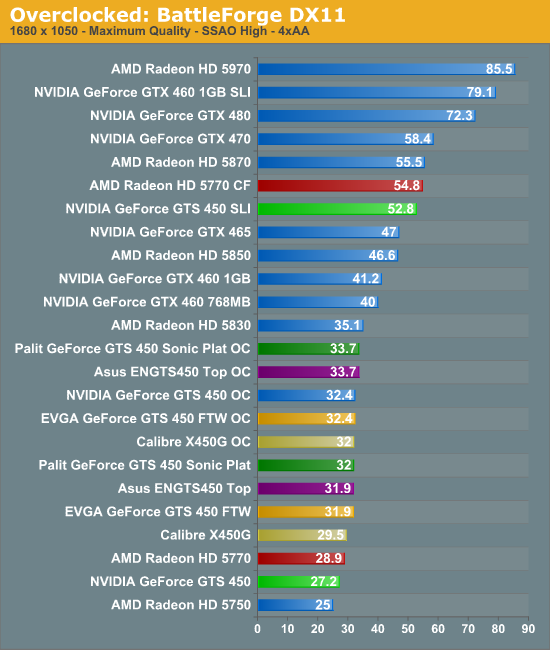
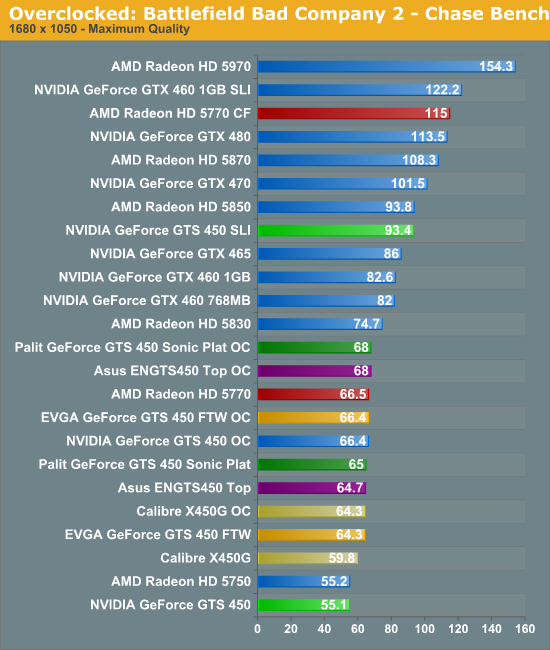
The results in our games follow the overclocks achieved, with the Palit and Asus cards topping the list, followed by the EVGA and Calibre cards. What’s immediately clear is that with already-hefty factory overclocks on the Asus, EVGA, and Palit cards, further overclocking isn’t nearly as productive. A 6% core overclock on the Asus card for example is good for around 5% more performance, but it doesn’t shift the results in any meaningful manner. Unless you could push one of these cards over 1GHz, further overclocking is more for show than it is to really improve performance.
The Calibre of course is the lone holdout from this statement. It may have had the lowest final overclock, but it also had the lowest factory overclock – we were able to give it another 10% on the core clock which allowed it to more or less close the performance gap between it and the other factory overclocked cards.
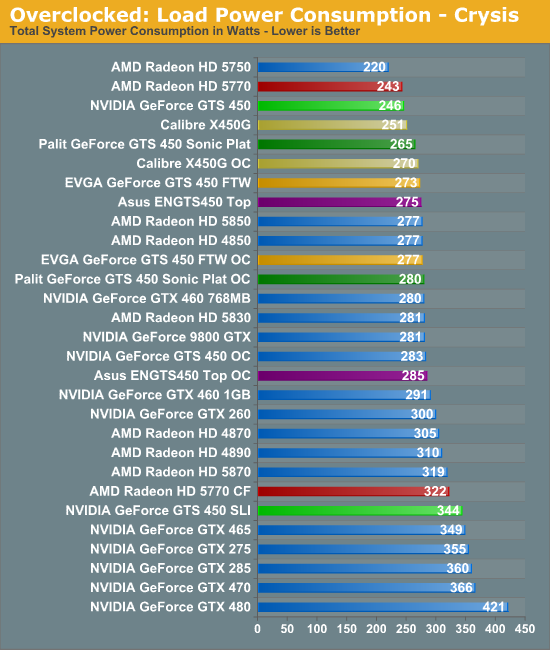
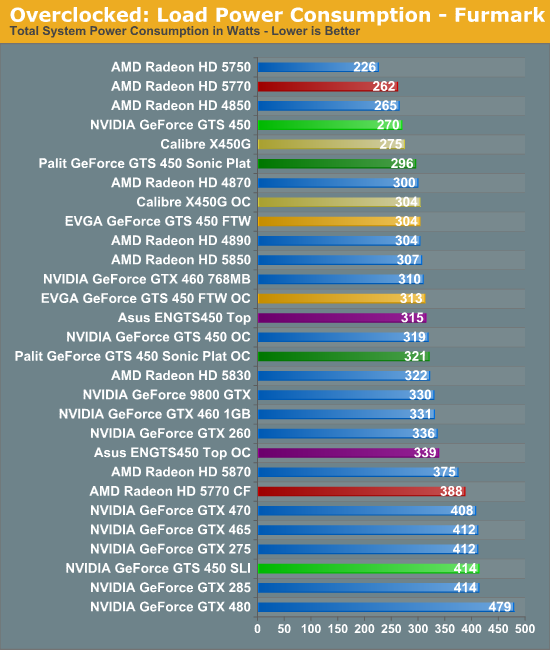

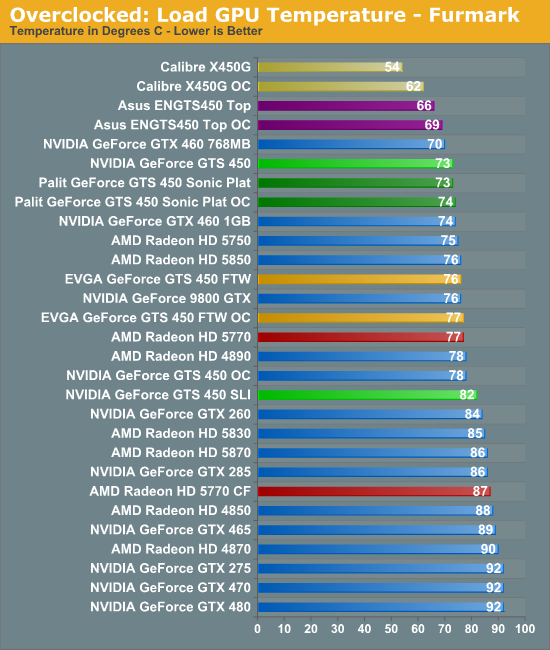

Since we went with 1.15v on all of our cards in order to try to find the highest reasonable overclock, all of these cards take a heavy hit when it comes to power, temperature, and noise. The Asus card does the worst here in terms of power thanks in a big part to its top overclock, followed by the Palit, EVGA, and Calibre cards. At this point we’re 30-40W over a reference GTS 450 in Crysis, and 35-70W in Furmark.
When it comes to temperatures, with the exception of the Calibre which jumps 8C, the extra voltage and overclocks has little impact on the GPU temperatures for our cards. The penalty is paid by the amount of noise generated, where all of these cards get 1-3dB(A) louder. Combined with the lackluster overclocking results, and this is probably a good reason to not bother with further overclocking except on the Calibre card.










16 Comments
View All Comments
Mathieu Bourgie - Tuesday, September 14, 2010 - link
Ryan,First of all, great review on the GTS 450. Not a bad card, but I agree that it's not at the right price. Seems like AMD saw this and the price cut on the GTX 460 768MB coming and got ready with a price cut on the 5770.
Cut the GTS 450 to $120 though and then it would be competitive, since it would be $20 away from the Radeon HD 5770 and only $10 more than a Radeon HD 5750, in both cases just enough to make you consider it. At $130, it's $10 away from a Radeon HD 5770 and going with the 5770 is a no brainer for me.
Bring the GTS 450 down to $110 and its a blockbuster, since it has no problem outperforming the Radeon HD 5750 at the price.
It's not a bad card at all, it's competitive, but it's not the hit that the GTX 460 is, especially now with the 768MB edition at $170.
Anyway, that said, I was wondering: Why not throw some overclocked Radeon HD 5770s performance data in the mix?
I mean, here we see how well the GTS 450 performance scales from stock, to factory overclocked and finally, to manually overclocked with additional voltage.
How about doing the same with a Radeon HD 5770 and compare the performance?
You took a look at the PowerColor Radeon HD 5770 Vertex about three weeks ago (http://www.anandtech.com/show/3868/quick-look-powe... which has a small overclock, which is still enough to improve performance a tad. You could at least add the data from that test in here, no?
Obviously, we all expect the overclocked Radeon HD 5770 to distance itself further away from the GTS 450. The question that I and I'm sure that others are also interested in is: By what % or how many FPS does a manually overclocked Radeon HD 5770 beat an manually overclocked GTS 450?
azcoyote - Thursday, September 16, 2010 - link
Ryan,What are the chances we could see a roundup of low-profile and/or passively cooled cards?
That segment of cards seems pretty hard to find and pick parts for when building with space constraints.
Thanks!
Wiley
Palitusa - Thursday, September 16, 2010 - link
Palit designed a Low Profile and is the First one to release World Wide.http://www.newegg.com/Product/Product.aspx?Item=N8...
It is half the size of GTS450!!
Ryan Smith - Friday, September 17, 2010 - link
I may be getting the Palit low-profile card soon. Stay tuned.Xpl1c1t - Thursday, September 30, 2010 - link
I'm tuned. More low profile cards need to impact the market these days.Mautaznesh - Friday, October 1, 2010 - link
I'd much rather go with an ATi card. Take advantage of the Eyefinity.